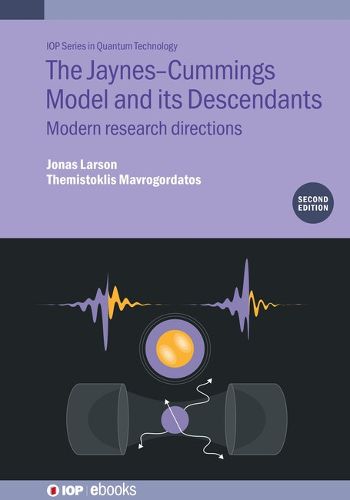Readings Newsletter
Become a Readings Member to make your shopping experience even easier.
Sign in or sign up for free!
You’re not far away from qualifying for FREE standard shipping within Australia
You’ve qualified for FREE standard shipping within Australia
The cart is loading…






This title is printed to order. This book may have been self-published. If so, we cannot guarantee the quality of the content. In the main most books will have gone through the editing process however some may not. We therefore suggest that you be aware of this before ordering this book. If in doubt check either the author or publisher’s details as we are unable to accept any returns unless they are faulty. Please contact us if you have any questions.
The Jaynes-Cummings Model (JCM) has been at the forefront of modern physics as one of the simplest, yet intricately nonlinear, models of light-matter interaction. Focusing on the omnipresence of the JCM across a range of disciplines, this significantly updated and comprehensive review conveys to the reader the fundamental generality of its formalism, looking at a wide range of applications in specific physical systems and across disciplines including atomic physics, quantum optics, solid-state physics and quantum information sciences. An ideal reference for researchers in quantum physics and quantum optics, the book also comprises an accessible introduction for students engaged with non-equilibrium quantum phase transitions, quantum computing and simulation, quantum many-body physics, cavity, circuit and waveguide QED.
Key Features:
Collects JCM physics and applications scattered across literature and different applications. The exposition guides the reader through a rich and appealing landscape interlacing quantum optics and condensed-matter physics. All chapters discuss theory and experiment, linked historically to the development of the various directions stemming from JC physics. This is accompanied by a thorough list of references to the key publications. The presentation is kept concise, while continuous text is interspersed with various illustrations and an economical use of mathematical expressions.
$9.00 standard shipping within Australia
FREE standard shipping within Australia for orders over $100.00
Express & International shipping calculated at checkout
This title is printed to order. This book may have been self-published. If so, we cannot guarantee the quality of the content. In the main most books will have gone through the editing process however some may not. We therefore suggest that you be aware of this before ordering this book. If in doubt check either the author or publisher’s details as we are unable to accept any returns unless they are faulty. Please contact us if you have any questions.
The Jaynes-Cummings Model (JCM) has been at the forefront of modern physics as one of the simplest, yet intricately nonlinear, models of light-matter interaction. Focusing on the omnipresence of the JCM across a range of disciplines, this significantly updated and comprehensive review conveys to the reader the fundamental generality of its formalism, looking at a wide range of applications in specific physical systems and across disciplines including atomic physics, quantum optics, solid-state physics and quantum information sciences. An ideal reference for researchers in quantum physics and quantum optics, the book also comprises an accessible introduction for students engaged with non-equilibrium quantum phase transitions, quantum computing and simulation, quantum many-body physics, cavity, circuit and waveguide QED.
Key Features:
Collects JCM physics and applications scattered across literature and different applications. The exposition guides the reader through a rich and appealing landscape interlacing quantum optics and condensed-matter physics. All chapters discuss theory and experiment, linked historically to the development of the various directions stemming from JC physics. This is accompanied by a thorough list of references to the key publications. The presentation is kept concise, while continuous text is interspersed with various illustrations and an economical use of mathematical expressions.